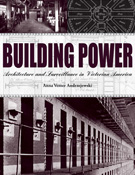Building Power
Architecture and Surveillance in Victorian America

- Author(s): Andrzejewski, Anna Vemer
- Series:
- Imprint: Univ Tennessee Press
- Publication Date: 2008-12-01
- Status: Active
- Available in Hardcover - Cloth: Price $39.00 | Buy Now
Building Power examines the ways in which concerns about surveillance informed the design and organization of important building types in the United States between the mid-nineteenth century and World War I. Beginning with settings such as prisons, that were specifically planned around surveillance, Anna Vemer Andrzejewski shows how surveillance also affected the design and use of various buildings and environments, including post offices, factories, offices, houses, and camp meetings. Working with great dexterity from case studies as well as scholarly sources, she argues that surveillance not only motivated a range of common buildings but was also a defining practice of modernism.
This wide ranging study draws on fundamental concepts from Michel Foucault, even as it revises and extends them. For Andrzejewski, surveillance is any act of sustained, close observation of others that is intended to transform behavior-of those under surveillance as well as those who initiate it. This definition allows her to illuminate the many ways in which those in positions of power have attempted to influence the actions of others, whether to create and enforce hierarchical boundaries between people, as in the workplace, or to affirm bonds between like-minded individuals, as at Victorian-era revivalist camp meetings. Thinking about surveillance in these terms also allows Andrzejewski to consider ways in which it has influenced diverse American spaces, ranging from obvious settings relatively removed from daily life (like penal institutions) to everyday spaces familiar to most Americans (like middle-class houses). Moving across the era, as well as across building types, she shows that as the goals and contexts for surveillance changed, so did its realization in the built environment, resulting in a complicated landscape that influenced both everyday life and the principles of modernism.
